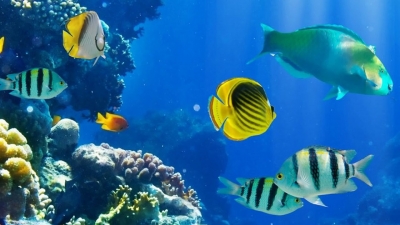
There are about 32,000 types of fish in the world’s oceans, lakes and rivers. They are divided into three groups. Bony fish have a light but strong bone skeleton, and are by far the biggest group. Cartilaginous fish, which include sharks and rays, have a skeleton made of a bendy material called cartilage. Jawless fish only include lampreys.
Teeth
Fish have different types of teeth, depending on their diet. Meat-eating fish have pointed teeth to cut into prey. Piranhas have tiny teeth, but they are razor-sharp. Sheepshead teeth look like just like ours—at least at first glance. They have 2 rows of molars in their lower jaws and 3 rows in their upper jaws. A sheepshead also has incisors at the front of the jaw and grinding teeth in the back of their jaw to expertly pulverize prey. And sheepshead fish steal more than our smiles—they are notorious for stealing bait. A relative of the piranha, pacu teeth are much squarer than their biting brothers. Their human-like chompers are due to their diet—pacu fish are omnivores and prefer to eat vegetables.
Eggs
Fish eggs, also known as roe, are an incredible food rich in micronutrients and Omega-3 fatty acids. And unlike fermented cod liver oil (the other fish-derived food so nutritious it counts as a supplement), they’re actually tasty, either plain or as an ingredient in all kinds of recipes. Nutritionally, fish eggs share one important benefit with fish oil supplements: they’re very high in anti-inflammatory Omega-3 fats. Since roe is a natural source of these fats, it even beats out a supplement for nutritional quality, since there’s much less risk of the fats oxidizing during processing.
Fins
Fins are usually the most distinctive anatomical features of a fish. They are composed of bony spines or rays protruding from the body with skin covering them and joining them together, either in a webbed fashion, as seen in most bony fish, or similar to a flipper, as seen in sharks. Apart from the tail or caudal fin, fish fins have no direct connection with the spine and are supported only by muscles. Their principal function is to help the fish swim. Fins located in different places on the fish serve different purposes such as moving forward, turning, keeping an upright position or stopping. Most fish use fins when swimming, flying fish use pectoral fins for gliding, and frogfish use them for crawling.
Gills
Fish gills are organs that allow fish to breathe underwater. Most fish exchange gases like oxygen and carbon dioxide using gills that are protected under gill covers on both sides of the pharynx (throat). Gills are tissues that are like short threads, protein structures called filaments. These filaments have many functions including the transfer of ions and water, as well as the exchange of oxygen, carbon dioxide, acids and ammonia. Each filament contains a capillary network that provides a large surface area for exchanging oxygen and carbon dioxide.
Dorsal fin
A dorsal fin is a fin located on the back of most marine and freshwater vertebrates such as fishes, cetaceans (whales, dolphins, and porpoises), and the (extinct) ichthyosaur. Most species have only one dorsal fin, but some have two or three.
Wildlife biologists often use the distinctive nicks and wear patterns which develop on the dorsal fins of large cetaceans to identify individuals in the field.
The bony or cartilaginous bones that support the base of the dorsal fin in fish are called pterygiophores.
Scales
Scales vary enormously in size, shape, structure, and extent, ranging from strong and rigid armour plates in fishes such as shrimpfishes and boxfishes, to microscopic or absent in fishes such as eels and anglerfishes. The morphology of a scale can be used to identify the species of fish it came from.
Most bony fishes are covered with the cycloid scales of salmon and carp, or the ctenoid scales of perch, or the ganoid scales of sturgeons and gars. Cartilaginous fishes (sharks and rays) are covered with placoid scales. Some species are covered instead by scutes, and others have no outer covering on part or all of the skin.
Jawless fish
The first fish did not have jaws, and the only ones alive today are lampreys. These long fish have a cartilage skeleton and a round mouth that has lots of teeth. Most lampreys attach themselves to other fish with their mouth and suck on their blood.
Most scientists agree that the jawless fish are part of the superclass Agnatha. They belong to the phylum Chordata, subphylum Vertebrata. There are two living groups of jawless fish, with about 100 species in total: lampreys and hagfish. Although hagfish belong to the subphylum Vertebrata, they do not technically have vertebrae (though they do have a skull), whereas lampreys do have vertebrae.
Picture Credit : Google




